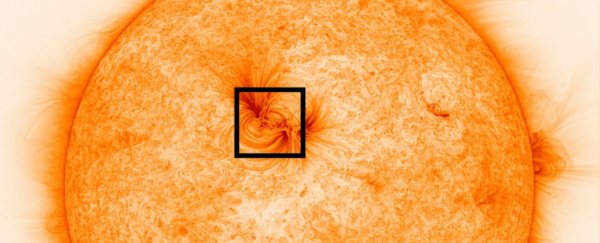Astronomers have delivered the closest look yet at the extremely hot outer corona layer of the Sun, revealing never-before-seen structures hidden within regions once only seen as empty or dark.
The new high-res images reveal magnetic threads up to 500 kilometres (311 miles) wide, with million-degree plasma flowing within them. The discovery brings fresh insights on the intense atmosphere of our home star.
The original data were captured by the High-Resolution Coronal Imager (Hi-C) in 2018. As the name implies, this telescope is designed to take high-resolution images of our Sun's corona; Hi-C can spot objects on the Sun just 70 kilometres (43 miles) in size, or 0.01 percent the total size of the star.
 (UCLan)
(UCLan)
"Until now solar astronomers have effectively been viewing our closest star in 'standard definition', whereas the exceptional quality of the data provided by the Hi-C telescope allows us to survey a patch of the Sun in 'ultra-high definition' for the first time," says solar physicist Robert Walsh from the University of Central Lancashire (UCLan) in the UK.
"If you are watching a football match on television in standard definition, the football pitch looks green and uniform. Watch the same game in ultra-HD and the individual blades of grass can jump out at you – and that's what we're able to see with the Hi-C images."
This ultra-HD view means that previously unseen parts of the Sun have now come into clear view, and that in turn can tell us more about how exactly the Sun's mysterious magnetic atmosphere is made up.
The magnetic field and plasma ropes (or coronal loops) that comprise the outer layer of the Sun are an important part of the mechanism that produces solar storms – activity that can ultimately affect us down here on Earth. Once we know more about how they're created, we can better plan for them.
There's still a lot we don't know about the structures in the outer layers of the Sun, and there are a lot of weird happenings in close proximity to the star, but recent advances in science and telescopy are starting to peel away some of the layers of mystery.
More research will be needed to understand the newly revealed plasma threads and their function, but the fact we can even see them at all is a huge step forward.
The next Hi-C mission should tell us even more about how the Sun's corona works, especially as the detailed data can be combined with imagery from other telescopes to build up an increasingly clear portrait of the Sun.
"This is a fascinating discovery that could better inform our understanding of the flow of energy through the layers of the Sun and eventually down to Earth itself," says solar physicist Tom Williams, from the University of Central Lancashire.
"This is so important if we are to model and predict the behaviour of our life-giving star."
The research has been published in the Astrophysical Journal.
